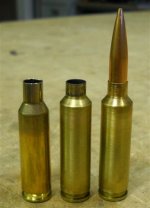The success of the Wolf Pup has been well established. Apparently another shooter has, perhaps inadvertently, made another very short neck chambering which shows promise.
So, two questions:
The first is, have you ever tried jumping bullets with the Wolf Pup, or does a jam seem important? If so, given the smaller frictional force available with the very short neck, is the amount of jam restricted?
The second is, can you think of any reason why we couldn't pursue testing of very short necked chamberings simply by using a conventional case (like the PPC), and throating out a barrel so bullet seating mirrored that of the WP? Bullet *alignment* may not be quite as good as with a WP, but everything else would seem to be the same. Or am I missing something?
* * *
If very short necks work well generally, I can think of several applications for competitive BR, both long and short range. For example, a PPC with the body/shoulder pushed forward like the WP would likely have a capacity similar to .30 BR, enabling different powder choices.
That's one of the potential benefits, being able to use very good quality brass while increasing the case capacity to match more/better powder choices.
Another is any gains there might be in bullet alignment/release with the very short neck. I realize this one will require more testing.
I've spent considerable time & money pursuing the benefits of fairly long necks, and finally concluded that there is nothing there. I don't meant to say there isn't an *ideal* neck length; I don't know that. But I'm pretty sure that there is no merit to just having a "long neck."
So, two questions:
The first is, have you ever tried jumping bullets with the Wolf Pup, or does a jam seem important? If so, given the smaller frictional force available with the very short neck, is the amount of jam restricted?
The second is, can you think of any reason why we couldn't pursue testing of very short necked chamberings simply by using a conventional case (like the PPC), and throating out a barrel so bullet seating mirrored that of the WP? Bullet *alignment* may not be quite as good as with a WP, but everything else would seem to be the same. Or am I missing something?
* * *
If very short necks work well generally, I can think of several applications for competitive BR, both long and short range. For example, a PPC with the body/shoulder pushed forward like the WP would likely have a capacity similar to .30 BR, enabling different powder choices.
That's one of the potential benefits, being able to use very good quality brass while increasing the case capacity to match more/better powder choices.
Another is any gains there might be in bullet alignment/release with the very short neck. I realize this one will require more testing.
I've spent considerable time & money pursuing the benefits of fairly long necks, and finally concluded that there is nothing there. I don't meant to say there isn't an *ideal* neck length; I don't know that. But I'm pretty sure that there is no merit to just having a "long neck."
Last edited:


